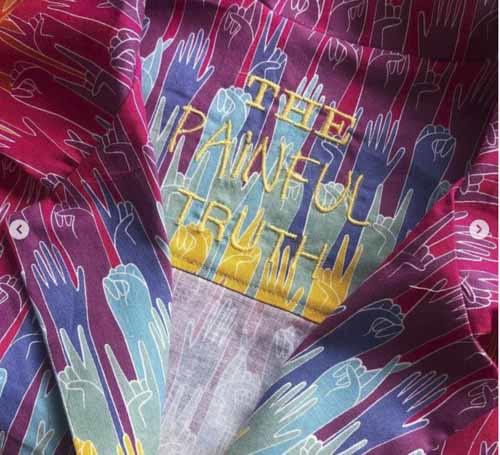New guidelines for the film and TV industry on portraying chronic pain on our screens
05 May 2021
Earlier this year we launched The Painful Truth, a campaign calling on the TV and film industry to increase and better represent chronic pain like arthritis in their storylines.
We know it's important that people with arthritis can feel represented, heard and seen so society can begin to understand the impact pain can have, from not being able to care for your family, socialise or even to move freely.
Over 4,000 of you told us how the lack of accurate portrayal of pain on TV and film screens affects mental health and sense of self, preventing people from speaking up and getting the support they need.
We spoke to Joel and Kalifa who have been involved in The Painful Truth campaign to get their thoughts on how arthritis is currently represented on our screens:
"The breadth and impact of chronic pain is not portrayed well in TV and film.”
Joel, 36, from Norfolk, lives with juvenile idiopathic arthritis, psoriatic arthritis, and chronic primary pain.
That hopeless position where no one is coming to save you and nothing can take your pain away – most people don’t understand this, and it's not what you see on-screen.
Imagine breaking your leg, going to hospital, and being told there is nothing there to fix it.
You put on a brave face all day, then later on all the emotion of the pain comes out as a huge mental health challenge. You're up at two in the morning, crying in the corner of the living room, unable to sleep.
Arthritis and chronic pain are where mental health was ten years ago, and portraying properly is going to take more than showing someone laying in bed screaming – yes, that’s part of it but there are many more layers, like finance, relationships, and work.
“Not seeing representation makes me feel alienated and almost as if my pain is not valid.”
Kalifa, 21, from West Yorkshire, lives with seronegative rheumatoid arthritis.
I have never witnessed an accurate portrayal of my pain on TV.
‘Pain’ is typically related to physical injury, labour, grieving, mental illnesses and never as long-term chronic pain.
When long-term pain is depicted, it is often through an elderly character, which again reinforces the assumption that long-term pain is linked to old age.
The guidelines
With your help, and alongside experts from the TV and film industry itself, we’ve created the first-ever guide to representing chronic pain on screen: The Painful Truth: A Guide to Depicting Chronic Pain on Screen.
This guidance for the TV and film industry aims to bring an increased and more accurate portrayal of chronic pain.
It includes helpful tips for creating pain storylines, alongside the lived experiences of people with arthritis to show what it is really like to live with arthritis.
Sharing your #ThePainfulTruth stories
We know that one of the most powerful ways to start changing perceptions, and get the TV and film industry to change, is by drawing on the powerful voices of people like you who are living with chronic pain.

To mark the launch of the guidelines, we asked you to share your #ThePainfulTruth story on Instagram, Facebook and Twitter.
We saw a huge response to the campaign and many of you posted photos and shared your #ThePainfulTruth stories.
We were so inspired by @jenlegg_teescreatives’ interpretation of #ThePainfulTruth campaign.
She chose to sew #ThePainfulTruth inside her shirt "as like any invisible illness with the correct medication I look alright. But it doesn’t always portray the truth."
She chose fabric with hands to symbolise her recent flare up affecting her hands.
You also shared how the new guidelines might help those in the industry represent your experiences accurately and more frequently on our screens.
"Absolutely brilliant! Thank you for your incredible efforts to make chronic pain understood and acknowledged 👏🙌"
"Campaign launch✨ Honoured to stand with @VersusArthritis on this and have contributed to the concept! What you see isn’t always #thepainfultruth and I’m proud to show a glimpse of my different truths!💙💜"
"@versusarthritis thank you! And thank you for running this amazing campaign. I did my dissertation on fair representation within the media. The impact it can have on society is huge ! 🙏💜"
"@VersusArthritis It's one thing to see myself represents as a Queer person in media, but there is so little representation of chronic pain, which as someone with Arthritis & Fibromyalgia is so, so important. Thank you for making such an amazing resource - you guys rock! 💕"
Share your #ThePainfulTruth story on Facebook, Instagram or Twitter to get involved.
Together, we can change the way the TV and film portrays chronic pain and raise awareness and understanding around the realities of living with arthritis.
What's next for the guidelines
We’ll be sending this guidance to film companies and TV networks and asking individuals in the TV and film industry to share this guide with their networks.
If you know someone working in the industry, please feel free to share the guidelines with them directly.
Download a copy of the guidance here.
We hope that this guidance will support the industry to use their power and encourage them to include the voices and experience of people with chronic pain like arthritis in a more accurate and meaningful way moving forward.
We’re here whenever you need us
- If you need advice or support, you can call our free helpline on 0800 5200 520
- Chat to our Arthritis Virtual Assistant
- Join our online community
- Stay in touch and follow us on Twitter, Facebook and Instagram.